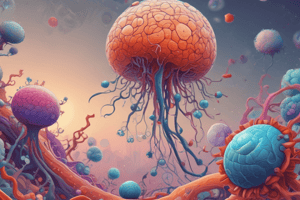Podcast
Questions and Answers
What is the main function of the plasma membrane?
What is the main function of the plasma membrane?
- To generate energy for the cell
- To synthesize proteins
- To provide structural support to the cell
- To separate the cell from its environment (correct)
What is the role of the cytoskeleton in a cell?
What is the role of the cytoskeleton in a cell?
- To provide structural support and shape to the cell (correct)
- To generate energy for the cell
- To synthesize proteins
- To respond to stimuli
Which organelle is responsible for generating energy for the cell?
Which organelle is responsible for generating energy for the cell?
- Mitochondria (correct)
- Ribosomes
- Lysosomes
- Golgi apparatus
What is the primary function of lysosomes?
What is the primary function of lysosomes?
What is the main function of the Golgi apparatus?
What is the main function of the Golgi apparatus?
What is the primary function of ribosomes?
What is the primary function of ribosomes?
What is the main characteristic that distinguishes prokaryotic cells from eukaryotic cells?
What is the main characteristic that distinguishes prokaryotic cells from eukaryotic cells?
What is the primary function of stem cells?
What is the primary function of stem cells?
Flashcards are hidden until you start studying
Study Notes
Cells
Cell Structure
- Plasma membrane: Semi-permeable membrane that separates the cell from its environment
- Cytoplasm: Jelly-like substance inside the cell where metabolic processes take place
- Cytoskeleton: Network of filaments that provides structural support and shape to the cell
- Nucleus: Membrane-bound organelle that contains the cell's genetic material (DNA)
- Mitochondria: Organelles responsible for generating energy for the cell through cellular respiration
- Ribosomes: Small organelles responsible for protein synthesis
- Lysosomes: Membrane-bound sacs that contain digestive enzymes and help break down waste
- Golgi apparatus: Complex of flattened sacs and tubes that process and modify proteins and lipids
Cell Functions
- Metabolism: Conversion of energy and nutrients into ATP
- Growth and Development: Increase in cell size and number, leading to tissue and organ formation
- Response to Stimuli: Ability of cells to respond to changes in their environment
- Reproduction: Process by which cells divide to produce more cells
- Transportation: Movement of molecules in and out of the cell through various transport mechanisms
Cell Types
- Prokaryotic cells: Lack a true nucleus, typically found in bacteria
- Eukaryotic cells: Possess a true nucleus, found in plants, animals, fungi, and protists
- Stem cells: Undifferentiated cells that can differentiate into various cell types
- Specialized cells: Cells that have unique structures and functions, such as nerve cells or muscle cells
Cell Structure
- Plasma membrane is semi-permeable, separating the cell from its environment
- Cytoplasm is a jelly-like substance where metabolic processes occur
- Cytoskeleton provides structural support and shape to the cell through a network of filaments
- Nucleus is a membrane-bound organelle containing the cell's genetic material (DNA)
- Mitochondria generate energy for the cell through cellular respiration
- Ribosomes are responsible for protein synthesis
- Lysosomes contain digestive enzymes that break down waste
- Golgi apparatus processes and modifies proteins and lipids through a complex of flattened sacs and tubes
Cell Functions
- Metabolism involves the conversion of energy and nutrients into ATP
- Growth and development involve an increase in cell size and number, leading to tissue and organ formation
- Cells respond to stimuli through changes in their environment
- Cell reproduction involves the process of cell division to produce more cells
- Transportation occurs through various mechanisms that move molecules in and out of the cell
Cell Types
- Prokaryotic cells lack a true nucleus and are typically found in bacteria
- Eukaryotic cells possess a true nucleus and are found in plants, animals, fungi, and protists
- Stem cells are undifferentiated cells that can differentiate into various cell types
- Specialized cells have unique structures and functions, such as nerve cells or muscle cells
Studying That Suits You
Use AI to generate personalized quizzes and flashcards to suit your learning preferences.



